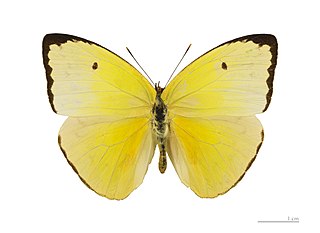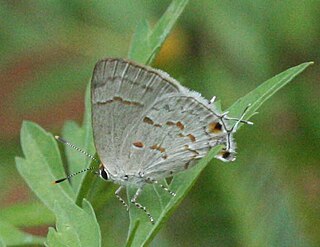
Zanthoxylum is a genus of about 250 species of deciduous and evergreen trees, shrubs and climbers in the family Rutaceae that are native to warm temperate and subtropical areas worldwide. It is the type genus of the tribe Zanthoxyleae in the subfamily Rutoideae. Several of the species have yellow heartwood, to which their generic name alludes.

Erinnyis obscura, the obscure sphinx, is a moth of the family Sphingidae. The species was first described by Johann Christian Fabricius in 1775. It lives from the northern part of South America up to the central United States.

Aphrissa statira, the statira sulphur, is a species of Lepidoptera in the family Pieridae. The species is a medium-sized yellow butterfly, with females more pale than males. They are found from southern regions of Florida and Texas through southern Brazil and northern Argentina. The caterpillars feed on the leaves of several local host plants, while adults prefer to feed on the nectar of red or orange colored flowers. The species is most noted for their dramatic migrations in the tropical areas of the Americas. They have been the subject of many studies about how butterflies navigate and orient during migration.

Pyrgus oileus, the tropical checkered skipper, is a species of skipper. It is found from Peninsular Florida, the Gulf Coast, and southern Texas, south through the West Indies, Mexico and Central America to Argentina.

Anthanassa frisia, the Cuban crescentspot, Cuban checkerspot or Cuban crescent, is a butterfly of the family Nymphalidae. Subspecies tulcis is known by the common names pale-banded crescent or Tulcis crescent; it is treated as a species by some authors. The nominate subspecies is found in the West Indies and southern Florida, with strays to northern Florida. Subspecies tulcis is found from Argentina north through Central America and Mexico to southern Texas, strays to west Texas and southern Arizona. Other subspecies are resident to South America.

Zizula cyna, the cyna blue, is a butterfly species in the family Lycaenidae.

Calpodes ethlius, the Brazilian skipper, larger canna leafroller or canna skipper, is a butterfly of the family Hesperiidae. It is found in the United States from southern Florida and southern Texas, south through the West Indies, Mexico, and Central America to Argentina. Strays and temporary colonies can be found north to southern Nevada, northern Texas, Illinois and Massachusetts.

Wallengrenia otho, the southern broken dash or broken dash skipper, is a butterfly of the family Hesperiidae. It was originally described by Smith in 1797. It is found from eastern Texas and the southeastern United States, south through the West Indies and Central America to Argentina. Strays can be found as far north as central Missouri, northern Kentucky and Delaware.

Phocides pigmalion, the mangrove skipper, is a butterfly of the family Hesperiidae. It is found in the United States from coast to coast in peninsular Florida and the Florida Keys, south through the West Indies and Mexico to Argentina. Strayed can be found up to coastal South Carolina.

Phocides polybius, the bloody spot or guava skipper, is a species of butterfly in the skipper family, Hesperiidae, that is native to the Americas. It is found from the lower Rio Grande Valley of southern Texas in the United States south through Mexico and Central America to Argentina. The species was first described by Johan Christian Fabricius in 1793.

Chiomara asychis, the white-patched skipper or white patch, is a butterfly of the family Hesperiidae. It is found from Argentina, north through tropical America to the West Indies and southern Texas. Strays can be found as far north as southern Arizona, Nevada and Kansas.

Tmolus echion, the red-spotted hairstreak or larger lantana butterfly, is a butterfly in the family Lycaenidae. It is found from Brazil, north to Sinaloa and Tamaulipas in Mexico. Rare strays can be found in southern Texas. It was introduced to Hawaii in 1902 to control lantana.

Papilio anchisiades, the ruby-spotted swallowtail or red-spotted swallowtail, is a butterfly of the family Papilionidae. It is found from southern Texas south to Argentina. Rare strays can be found up to Kansas, southeastern Arizona, and western Texas.

Phoebis neocypris, the tailed sulphur, is a butterfly in the family Pieridae. It is native to Mexico, Central America, and South America. There is a record for one stray in southern Texas. The habitat consists of tropical areas, especially in mid-elevation forests as well as open and disturbed areas.

Enantia albania, the costa-spotted mimic-white, is a butterfly in the family Pieridae. It is native to tropical Mexico and Central America, but rare strays have been reported from the Lower Rio Grande Valley in Texas. The habitat consists of low- to mid-elevation tropical forests and coffee plantations.

Hamadryas februa, the graycracker, is a species of cracker butterfly in the family Nymphalidae. It is found from Argentina north through tropical America to Mexico. Rare strays can be found up to the lower Rio Grande Valley in southern Texas. The habitat consists of subtropical forests, forest edges and cultivated areas with trees.

Rekoa palegon, the gold-bordered hairstreak, is a butterfly in the family Lycaenidae. It is found from Argentina north to Mexico and the West Indies. A rare stray has been recorded from southern Texas.

Heliopetes laviana, the Laviana white-skipper or Laviana skipper, is a butterfly in the family Hesperiidae. It is found from Argentina through Central America and northern Mexico to southern Texas. Strays can be found in southern Arizona and central and northern Texas. The habitat consists of edges of brushy areas, trails, roadsides, open woodland, thorn forest and streamsides.

Ministrymon clytie, the Clytie hairstreak, is a butterfly of the family Lycaenidae. It was described by William Henry Edwards in 1877. It is found from southern Arizona, New Mexico and Texas to Mexico, Guatemala and Costa Rica. The habitat consists of tropical forest openings and subtropical thorn forests.

Cyanophrys herodotus, the tropical green hairstreak or tropical greenstreak, is a butterfly of the family Lycaenidae. It was described by Johan Christian Fabricius in 1793. It is found in Mexico, Guatemala, Panama, Nicaragua, Colombia, Ecuador, Peru, Bolivia, Brazil, Paraguay and Argentina. Rare strays can be found as far north as southern Texas. The habitat consists of open disturbed areas in tropical and subtropical rainforests and cloudforests at altitudes ranging from 600 to about 2,000 meters.





















